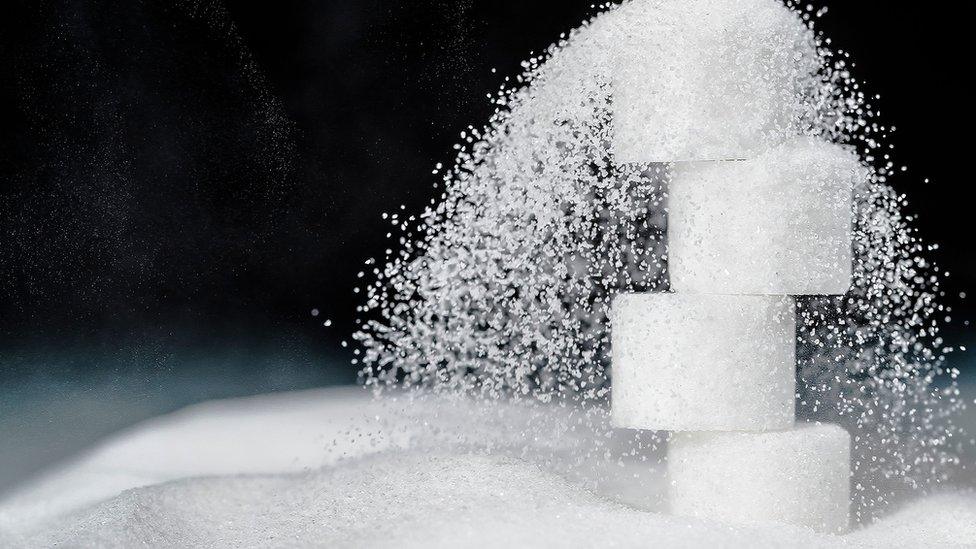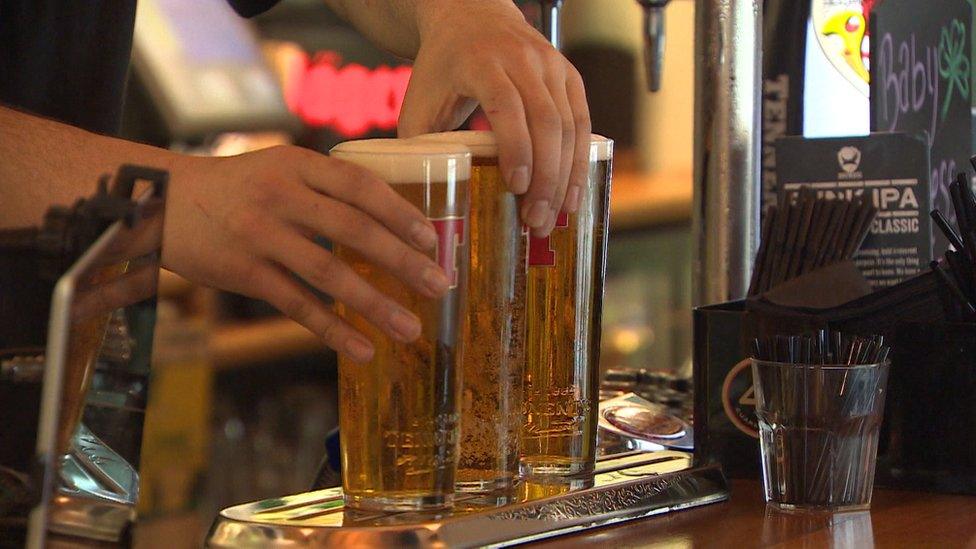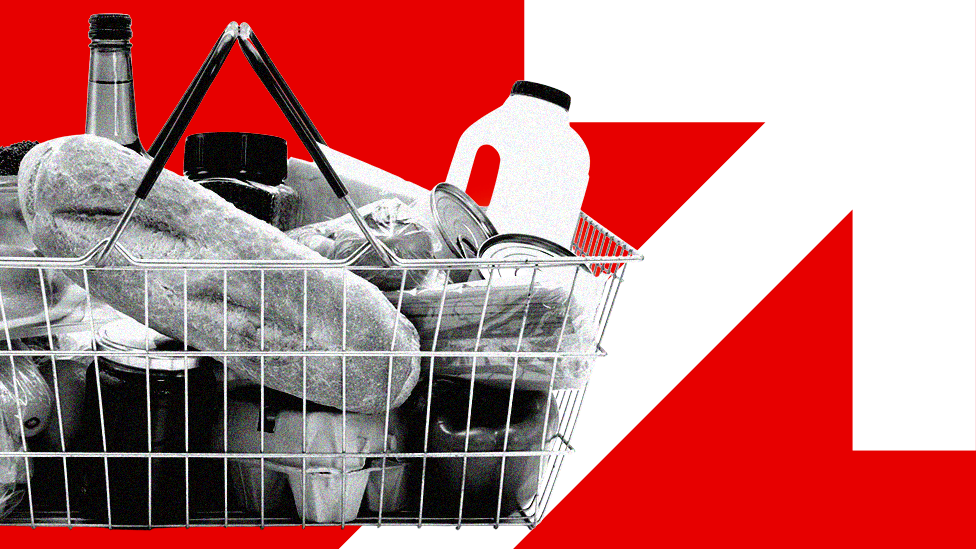Inflation is still brewing
- Published

The Competition and Markets Authority wants to ensure supermarkets are bringing down food prices when they can
Headline inflation has fallen, but core inflation remains stubborn and rising.
Services are rising in cost, as goods prices put a bit less pressure on household budgets. But food costs continue to leave a bad taste.
Alcohol has not faced the same price increases as other items in the past year, as brewers and the on-trade have sought to retain market share. New figures from the owner of Tennent's show that is succeeding, and the brand has become even more dominant in Scottish pubs.
Consumer price inflation was down last month, and by quite a lot - from 10.1% to 8.7%. It's taken a long time to get out of double digits, but there are warning signs in there.
One is that core inflation - stripping out the more volatile elements of energy and food prices - has risen, and remains stubbornly high.
That is one of the figures more closely watched by the Bank of England when setting its interest rates. And the latest figures from the Office for National Statistics (ONS) could be a reason for continuing to raise its base rate, above 4.5%.
We're seeing some shift from the rising cost of goods to the rising cost of services. That reflects a number of factors, including the labour costs of providing services, as workers gain price increases to pay more for their energy and food, and so managers put up bills.
That's the kind of wage-price spiral that the Bank of England is keen to stamp out. Its chief economist went off-message when he said we just had to get used to being worse off. He had to retreat, but his point still stands.
Some services are holding back on passing on inflation, because customers have less income or their service is discretionary and they don't want to lose market share.
The rising cost of "hairdressing and personal grooming" peaked four months ago at 7.1%, and has eased down to 6.3% in the year to April. Inflation has been much higher for the hardware you need to manage your locks and looks.
The cost of participating in sport is up 3.9%. The cost of attending sport is up by 5.2%. The price of a ticket for the cinema or theatre was increasing quite fast a year ago, as they re-opened post pandemic and people were eager to go out. But in the past year, prices have hardly changed.
The services of a plumber, painter or carpenter might be hard to secure, but according to the ONS, price inflation has been below 2% for over a year. (That's not in my experience, mind you.) Car maintenance and repair is seeing inflation picking up, at more than 9%. The same can be seen with driving lessons.
The cost of financial services is up by more than 2% for the first time in over a year. It turned negative for bank charges (while they milk profits from the widened gap between lending and borrowing interest rates) and it's up by more for an investment adviser.
Watch out for your next car insurance bill. For motor vehicles, insurance is up by more than 40% on last year. The industry is blaming higher costs of labour and of parts.
Sugar high
Food is outside core inflation, but not for anyone who needs it, which is all of us. And price inflation remains very high, at 19%. To be clear, that's an average of one-fifth more to buy the same food as last year.
Among the higher risers, sugar costs 47% more than April last year, reflecting global prices. Potatoes are up 25%. Olive oil is up 46%. Eggs up 37% and low-fat milk is up 33%.
So it's no surprise that people are trading down to cheaper brands of food, and buying less of it.

Sugar costs 47% more than in April last year
Food is classified alongside soft drinks, which have also been rising rapidly in price, and for less obvious reasons than the you'll find in the global and European supply chains for food.
Mineral water costs more than it did to package and transport. But does that justify an average increase of 21.4%? In the year before that, its price rose 13.2% - nearly double the rate of food inflation a year ago.
The Competition and Markets Authority is looking closely at pricing of groceries, to make sure that supermarkets are competing effectively, and bringing down prices when they can. They might want to take a look at bottled water.
Cheers
And what about booze - something to drown one's inflationary sorrows? Alcohol has been relatively resistant to the price increases seen elsewhere, and that's despite the same packaging and transport increases seen in soft drinks.
During the whole of 2022, the ONS says that alcohol prices rose by only 2.5%. But in the year to April, that has accelerated to 7%. The cost of spirits is up 6.2%, of wine 5.7% and beer by 7.2%.
Alcohol pricing is less volatile than food, because it does not have the same quick supply lines, affected by weather, harvests, and global demand.
Brewers, distillers, pubs and off-sales are better able to choose when to set prices and when to pass on costs, and they have done so in recent months to protect market share and to encourage people back into on-sales in bars and restaurants.
Across much of the on-trade, the cost of heating and lighting, and of recruiting and retaining staff, has put up costs a lot more than their prices have gone up.

New figures from the owner of Tennent's show the brand has become even more dominant in Scottish pubs
In the case of Tennent's, the biggest-selling Scottish on-trade beer, they have transitioned out of the pandemic closures with notable success. Its Irish-based owner, C&C, issued full-year financial results on Wednesday morning. These showed the volume of Tennent's sold was up 5% in the year to February, including a 26% increase in pints pulled in the on-trade. That implies a significant hit to off-sales.
Tennent's share of total beer sold in Scotland is up by nearly two percentage points, to reach nearly 30%. In pubs and restaurants, the lager brand has secured 60% of mainstream beer sales in Scotland. Across all beer, C&C says that half of all pints poured in Scotland are Tennent's.
Not everything at the parent company has been pouring quite as smoothly. It's having more difficulty in re-establishing the market for Magners cider.
And its British distribution arms, Bibendum and Matthew Clark, have had a horrible time of transition to new sales and supply management software. The disruption is setting the company back by 25 million euros, and it has cost the chief executive his job.
- Published15 November 2023


